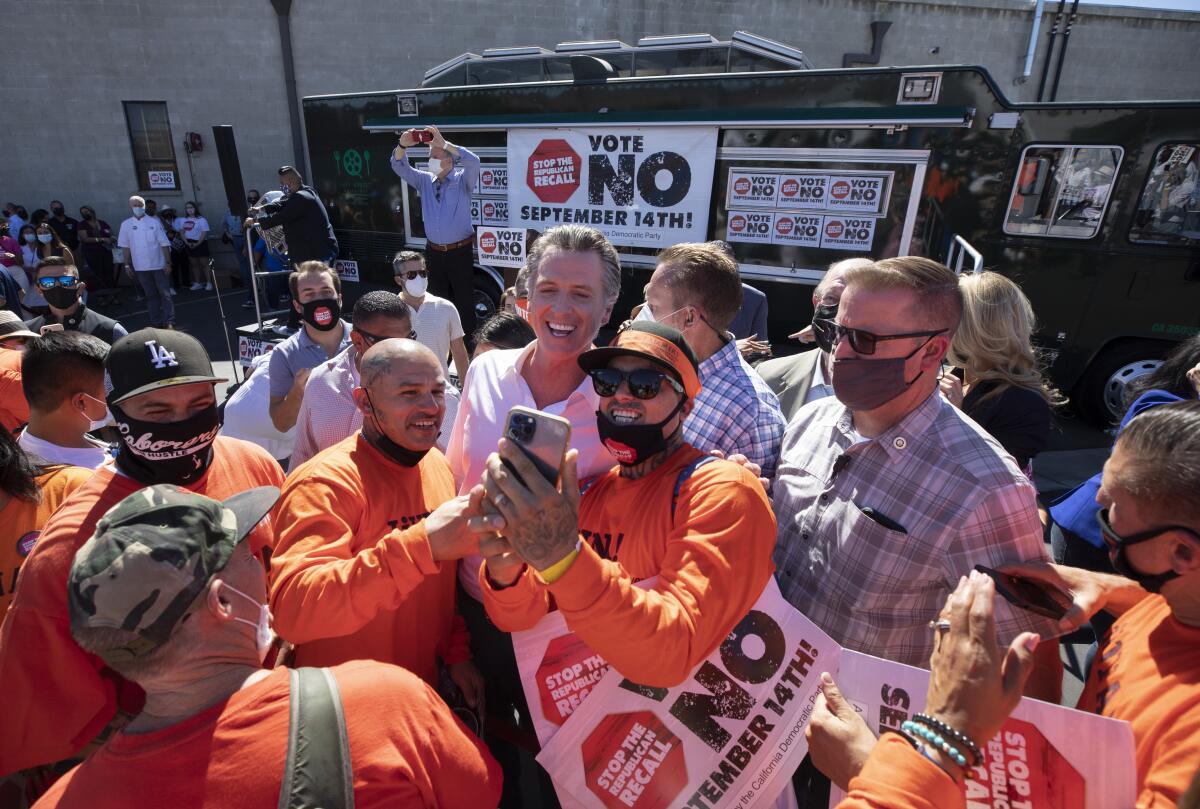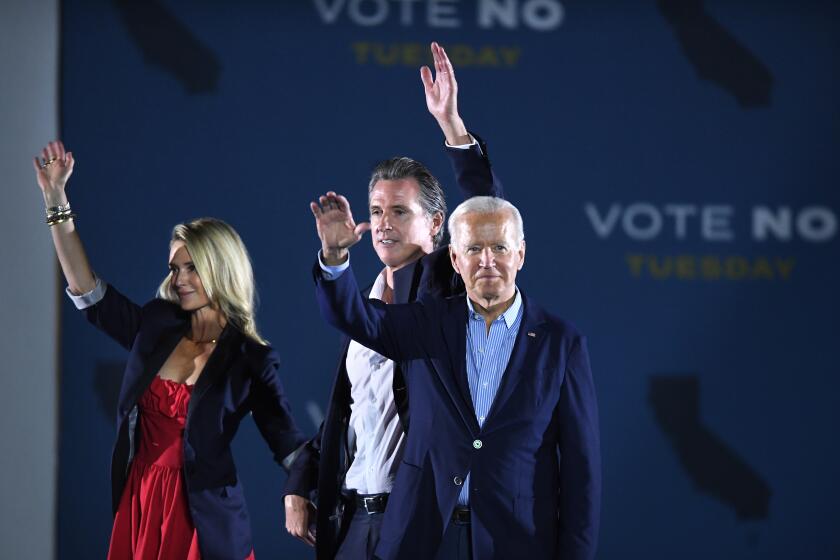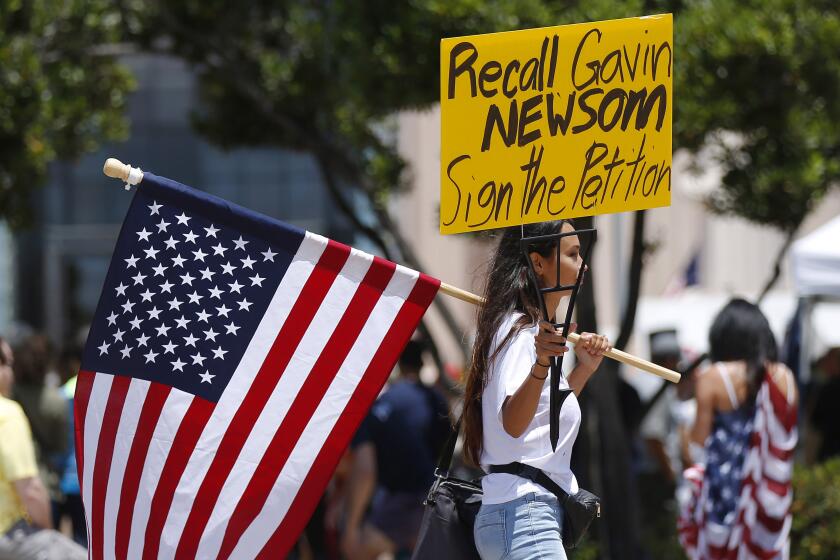News Analysis: As recall campaign closes, Californians might be ready to change the system

Though the recall election facing Gov. Gavin Newsom comes to an end Tuesday, its effect on California politics could linger. And for perfectly good reasons.
Launched by conservative critics and fueled by anger and fear over the state’s COVID-19 restrictions, the campaign has shined a light on the rules governing recall efforts, with academics and activists alike saying improvements are long overdue.
Now polling indicates voters might be ready for changes too. At least up to a point.
“They don’t want anyone to take away their option of a recall election, that’s for sure,” said Mark DiCamillo, survey director for UC Berkeley’s Institute of Governmental Studies. “But if it’s a serious debate about reforming the state Constitution, in my judgment it will be on solid ground if the reforms are not seen as partisan-based.”
New results released Monday from the institute’s poll, co-sponsored by the Los Angeles Times, show 75% of registered voters want to keep their right to remove a statewide official through a recall election. Strong majorities of almost every voter subgroup agreed in the survey conducted during the first week of September. Support for keeping recalls as an option was nearly unanimous among Republicans.
But the poll of almost 10,000 registered voters also sampled opinions on five ideas for revamping the rules governing statewide recall elections, a tool of California’s vaunted direct democracy system that has hardly been changed since its creation in 1911.
Among the five proposed changes, the broadest support was for holding a runoff election when a recall succeeds but no replacement candidate wins a majority of votes. The idea was supported by 63% of voters, though it was less popular among Republicans, only 41% of whom were in support.
The dynamics of the race to replace Newsom if he is recalled tell an important story behind the numbers.
Multiple public polls have shown that the 46 candidates on the ballot — running in a contest that counts only if most voters agree to remove Newsom — wouldn’t even come close to majority support.
The president joined Gov. Newsom Monday evening in Long Beach, capping off a day of campaigning by most of the recall election’s leading candidates.
The UC Berkeley survey found that almost one-third of likely voters said they are skipping the question on the ballot asking them to choose a replacement. And the front-runner in the contest, Republican talk radio host Larry Elder, has the support of just 38% of those voters who will participate in the second part of the recall election.
Critics have argued that it’s undemocratic — and might not pass constitutional muster — to require an incumbent to win support from a majority of voters but allow a new governor to take office having secured only a plurality of votes. The current rules create the possibility that even an unpopular governor could be the choice of more voters than the person who’s allowed to take over the job.
The issue briefly surfaced in the 2003 recall when then-Gov. Gray Davis was replaced by Republican Arnold Schwarzenegger. But it was a moot point by election day, when Davis won fewer votes on the recall ballot’s first question than Schwarzenegger did among the 135 replacement candidates.
But at the time, any statewide election could result in a split electorate if three or more candidates appeared on the November ballot. That ended with the adoption in 2010 of California’s top-two primary, in which only two candidates advance to the fall election. The recall is now the only way to hold statewide office without having to win more than 50% of the votes cast in an election.
In regional elections, as well as those held to fill a vacant congressional or legislative seat, runoffs are commonplace.
“We have runoffs in a lot of local elections, so it kind of conforms to established norms,” DiCamillo said.
The next most popular modification in the Berkeley IGS poll would limit recall elections to targeting an incumbent whose conduct is illegal or unethical, a change favored by 60% of voters surveyed. The concept, which was not described in detail in the poll, was especially popular with Democrats with 78% support and unaffiliated, independent voters at 58%.
Less well-liked, but still drawing the backing of a majority of voters surveyed, would be an effort to raise the bar for getting a gubernatorial recall on the ballot. Fifty-five percent of voters said they would favor a constitutional amendment requiring proponents to collect voter signatures equal to 25% of all ballots cast in the most recent election of a governor.
The existing standard, signatures equaling at least 12% of the votes in the last election, remains as it was in the early 20th century, long before paid petition drives sharply increased the odds of getting something on the ballot.
Newsom’s critics collected more than 1.7 million valid voter signatures to trigger Tuesday’s special election. Under the threshold envisioned by the poll, they would have been required to turn in about 3.1 million signatures.
The poll found that only a bare majority of voters support a change that makes it harder to run as a replacement candidate. Asked whether the state should increase the current $4,000 filing fee or the alternate requirement that a candidate collect at least 7,000 voter signatures, only 51% of voters gave their approval. The strongest support came from Democrats.
Interestingly, one of the most widely discussed potential changes to the process during the current recall campaign — requiring the embattled incumbent to be listed among the replacement candidates — was also the least popular in the poll. Only 42% of voters thought it to be a good idea.
The proposals in the poll are hardly the only ideas floating around for how to improve the recall process. Others have suggested following the possible intent of existing constitutional language governing recalls — a provision approved by voters in 1974 that says a replacement election should be held “if appropriate.”
California will have its second gubernatorial recall in 18 years. Why is this liberal state so recall crazy?
Mark Paul, a former state deputy treasurer and author of a 2010 book on reforming California’s government, said that provision should be interpreted to mean that removing a governor by recall elevates the lieutenant governor to the top job.
Paul said it seems a replacement election is “appropriate” only for statewide and legislative posts for which there’s no duly elected second-in-command. And he believes an up-or-down election would allow all voters — including those from the incumbent’s political party — to more fairly judge the reasons for possible removal.
“If you had the governor replaced by the method already in the California Constitution, you would basically turn the recall into the people’s impeachment,” Paul said.
Otherwise, voters who like a governor’s agenda but dislike the person behind it might find themselves in a no-win situation, particularly if the politician’s behavior has been beyond the pale.
But the biggest challenge to rethinking recall elections may be what could be called a political Catch-22: The only time California voters are motivated to rethink the rules of recall elections is also the moment in which they are most suspicious of the kind of bipartisan agreement on which such reforms would depend.
More to Read
Start your day right
Sign up for Essential California for news, features and recommendations from the L.A. Times and beyond in your inbox six days a week.
You may occasionally receive promotional content from the Los Angeles Times.









